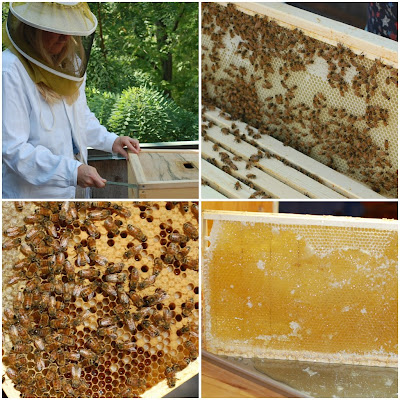There have been lots of questions about the bees, and many can't
(or don't wish) to come visit, so I've created a place to share their story. I'll use this space to post photos and write about my varied and sometimes manic interests of the day.

First, here is the "package" in which my 2-3# of bees arrived on May 30. Inside, there was a can of sugar syrup (food for the trip) and a queen, in her own compartment.
I picked up my package of bees from
Nancy the Beekeeper in Woburn.

The queen was accompanied by 4 "attendants." She was marked with a blue dot of paint so a beginner like me can find her. More on the queen later. Mostly I just try not to disturb her--she knows how to do her job. I also pray I don't squash her, because if I do, the whole colony is doomed.

This is a Langstroth hive. Each box is open at the top and bottom and has 10 frames of wax foundation (imprinted with the hexagonal design, which the bees use to build out comb. They make babies and store food in the comb. The frames are spaced apart for bees to build comb and leave their favorite 3/8" "bee space" to move around.
Each box--the lower ones called "hive bodies" the ones stacked above called "supers" are like a filing cabinet. You can move these frames around like files. The unit has a base, inner cover and outer cover. The people at the container store would love this--lots of accessories and ways to organize and expand.

I sprayed them with simple syrup through the screen of the package, removed three of the frames, and literally dumped them into the hive. It turns out that they can't really fly away or sting you when they are wet like that.

For a month now, the bees have been building comb, collecting pollen and nectar, the Queen has been laying eggs, and the nurse bees have been tending them. Since gestation is 21 days for worker bees, the first batches are being born now, and things are getting crowded. They were due for an addition, so on Saturday, I added a second hive body.
The top short box is actually empty except for a feeder jar with simple syrup. It's good to have on hand when bees are setting up a new hive.
 Snow Farm, in Williamsburg MA (near Northampton), hosted an artists' sale today--pottery, glass, jewelry, wood turning, textiles.
Snow Farm, in Williamsburg MA (near Northampton), hosted an artists' sale today--pottery, glass, jewelry, wood turning, textiles.











































